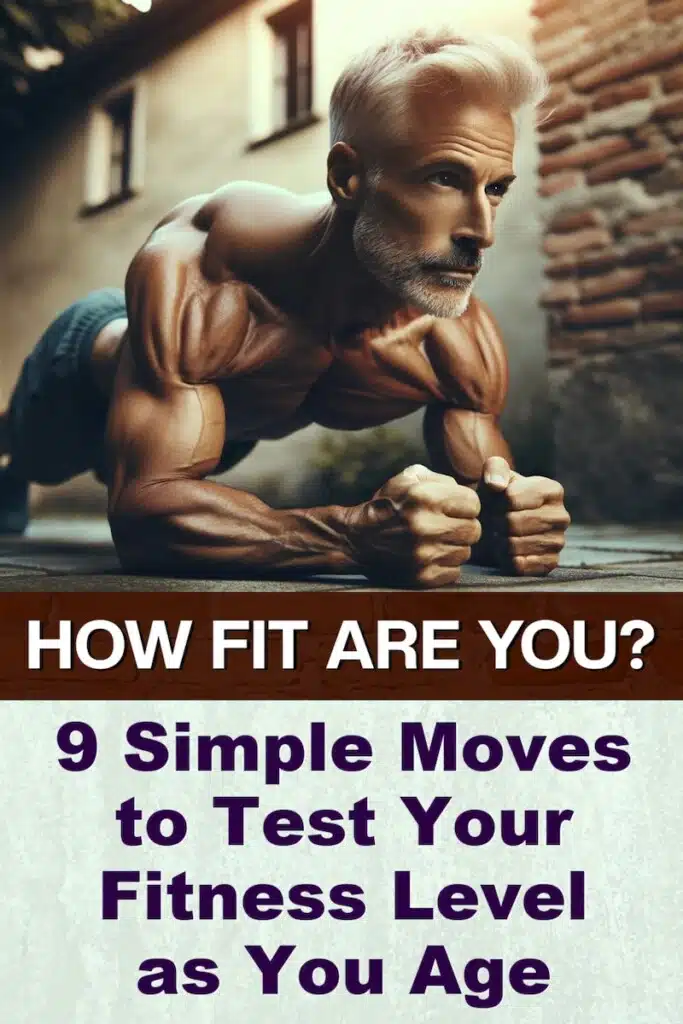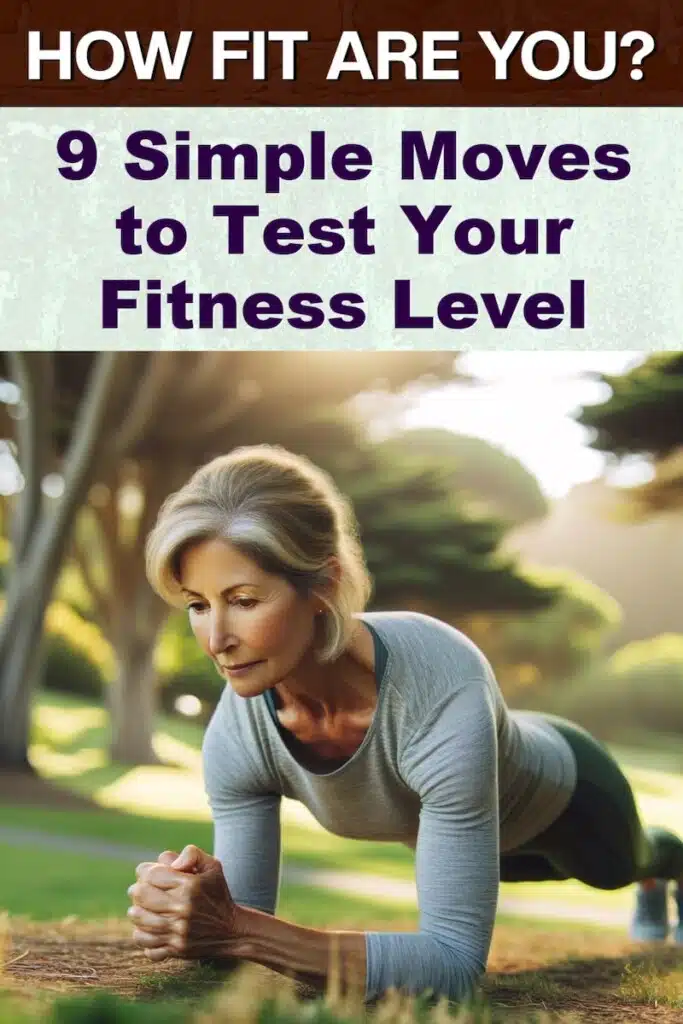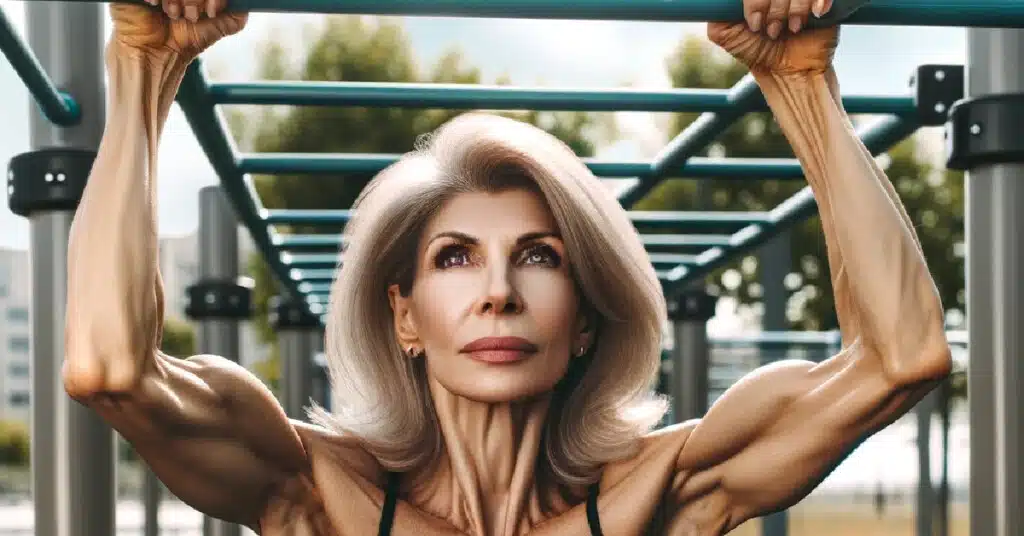The aging process is an adventure-filled journey with both positive and negative aspects. As you get older, it’s crucial to tend to your physical fitness to ensure you maintain a higher quality of life. Regular exercise is essential, and it’s also important to assess your current fitness level to identify areas for improvement. This age fitness test, comprising 9 simple moves, will help you determine how healthy you are so you can set goals for the future.
Additionally, below my descriptions of the nine moves, I’ve included a rubric tailored to your age group that will guide you through the ideal number of reps, time, or general results for each movement.
Improve Your Quality of Life with This Free Age Fitness Test
Everyone is aging in every moment.
You are aging, too.
And, as you age, you will likely accumulate a wealth of experiences and knowledge that can lead to profound wisdom and a deeper appreciation for life’s simple joys.
You might find yourself more at peace with who you are, more confident in your decisions, and more able to savor the present moment.
However, aging also presents a unique set of challenges and responsibilities.
Your body may not function as it once did, requiring you to adapt your lifestyle and prioritize your health so you can sustain – or even improve – quality of life. An age fitness test can be helpful with this.
What the Aging Experts Mean When They Talk about “Life Quality”
A high quality of life – in the context of aging – refers to the ability to maintain a deeply satisfying and meaningful existence as you grow older.
Life quality encompasses various aspects of well-being – including physical health, mental and emotional wellness, social engagement, and a sense of purpose.

A higher quality of life means being able to perform daily activities with relative ease, manage chronic conditions effectively, and maintain independence for as long as possible.
It also involves having strong social connections, engaging in activities that bring joy and satisfaction, and feeling a sense of belonging within your community.
Mentally, a high quality of life entails having a positive outlook, effective coping strategies for stress and change, and a sense of resilience in the face of challenges.
Ultimately, life quality while aging is about being able to adapt to changes, physically, mentally, and emotionally. It’s about finding meaning and purpose in daily life and maintaining a sense of autonomy and control over your circumstances. It means having poise, purpose, and able-bodiedness.
This age fitness test can give you valuable information to present to your doctor or physiotherapist if you’re concerned you are becoming arthritic, stiff, or experiencing back pain or joint discomfort. In fact, I recommend that you speak with your healthcare professional before conducting this test.
Age Fitness Test: Do These 9 Moves to See How Healthy You Are
By prioritizing physical health, you can increase your chances of experiencing a high quality of life throughout your mature years. This fitness age test can be an important part of that process.
Try each of these moves to assess your current level of fitness and to get a quick snapshot of how you’re aging.
This test is intended to be shame-free, meaning its purpose is to provide you with an honest and objective assessment of where you’re at in terms of strength and mobility for someone your age.

I encourage you not to be hard on yourself if you find any of the movements difficult or undoable.
Give yourself some grace. We’re all of us aging, and we’re all of us just trying to face the aging process with courage and a sense of humor.
These assessments are opportunities for growth and that’s all they’re intended to be.
Use your phone’s timer when applicable, and your phone’s video camera to check your form.
This probably goes without saying, but please listen to the needs of your body and proceed cautiously. Be especially mindful when doing any age fitness test.
1. Chair Sit-to-Stand Test
Do not count any rep in which you experienced pain in your lower back or knees.
Interestingly, scientists say this test has long-term predictive validity, meaning it’s a quick and eerily accurate way to assess your health and your functional capacity for a problem-free future.
- Sit in a chair with your arms crossed over your chest.
- Stand up and sit down as many times as possible within 30 seconds.
This tests your lower body strength and endurance.
If you feel pain for more than one rep, stop the test.
Recent research pooled data from five international rehabilitation studies, assessing outcomes like the ability to perform this 30-second sit-to-stand test, found that it was the most favorite way to assess function at an Intensive Care Unit or hospital discharge in moderate to severely ill participants. In other words, the better performance during the test, the easier time patients had not only while in ICU, but also after discharge when they returned home.
Another significant study in patients with chronic obstructive pulmonary disease found that over a 5-year period, this sit-to-stand test was strongly associated with mortality and moderately associated with health-related quality of life.
2. Lying-to-Standing Test
It’s worthwhile to learn now how to properly get up off the floor without damaging your hip. And with age, this ability only becomes more crucial.
The lying-to-standing test is a more advanced variation of the sit-to-stand. This time, instead of counting reps, you are simply tracking the amount of time it takes you to do only one rep.
- Lie flat on the floor, looking up.
- Roll over gently and slowly so that you’re now lying on your side.
- Use your top arm as a lever, pressing against the floor until you are sitting up.
- Lift one leg up and put a foot flat on the floor in front of you.
- Press both hands against your front thigh to help you move into a standing position (engaging your core muscles as you do so).
A 2012 study highlighted that this rising test was a significant predictor of mortality among participants aged 51 to 80. Sitting on the floor and then standing up without assistance from anyone else, is considered an indirect marker of overall health – reflecting cardiovascular health, balance, agility, flexibility, and core and leg strength.
If you can do this test relatively easily without feeling any knee or back pain, this is a good thing.
3. Prone Head Turn
This one is a bit controversial, but from my perspective, this test is imperative to help you assess a loss of neck mobility. It can take you by surprise!
- Lie on your front (prone) with face downward, then turn your head to one side. Try to relax into this position for 30 seconds. If you can do it without discomfort, this is a positive prognosis.
- Repeat, turning your head to the other side.
4. Walking Video
This might be the most important test of them all.
Admittedly, it’s very subjective – but vital nonetheless.
- Set up your phone camera across the room (or have a friend help you film it) and then simply walk toward the camera like you would normally walk.
- TIP: don’t change your posture just because you’re being filmed. Honestly, walk like you would normally walk if you weren’t even thinking about it.
- Play back the video, and look at your walk objectively.
- Do you seem like a stiff walker? Is there anything asymmetrical happening, like favoring one leg over the other, or one leg turned outward farther than the other?
5. Farmer’s Carry
I subscribe to a channel that streams the Ninja Warrior franchise from various places. My favorite is the Indonesian version because I’ve noticed almost all the contestants there are natural (no anabolics). This gives me an opportunity to see exactly at what point a fitness test takes people by surprise, especially people who think of themselves as very fit.
Sometimes you get bodybuilders or marathoners who think they’re going to ace the competition only to find, often to their own shock, that they fall in the water almost right out of the gate (if you haven’t seen the show – when an athlete misses a landing, they usually end up plunging into a murky moat below).
Why?
The reason most often is grip strength. Their grip simply gives out way before the major muscles of their chest, back, or quads do.
Research has consistently shown that grip strength is a robust biomarker for assessing overall health and a significant indicator of mortality risk across various populations.
For example, a study analyzing older hypertensive adults found a notable reduction in mortality risk for every increase in grip strength. Similarly, a comprehensive study involving half a million UK participants highlighted that weak grip strength is associated with various disease outcomes.
To do a farmer’s carry test:
- Pick up a pair of dumbbells that (together) match your body weight, and walk while holding the weight for one full minute. (If you can’t carry your full body weight, try half.)
- If you feel pain, stop. If the weights feel like they’re about to slip from your hands, stop.
6. Yoga Tree Pose
A yoga tree pose helps improve focus, concentration, and stability. However, it’s also a highly effective way to test your current ability to balance.
The ability to maintain balance is vital as you age because it helps you prevent falls, maintain mobility, and preserves your independence.
As you get older, your body undergoes changes that can affect your balance – such as reduced muscle strength, decreased flexibility, impaired vision, and diminished sensory perception in your feet and ankles.
These factors, combined with the potential side effects of medications and the presence of chronic conditions, can significantly increase the risk of falls.
Falls are a leading cause of injury, hospitalization, and even death among older adults, making balance training an essential component of healthy aging.
Good balance enables older adults to remain active and participate in daily activities with confidence, contributing to a higher quality of life and a greater sense of autonomy.
Therefore, prioritizing balance training as part of a your comprehensive fitness routine is crucial to maintain your health, independence, and overall well-being.
Remember, above, when I talked about Ninja Warrior?
Well, the other reasons that athletes drop into the water unexpectedly is that their balance, core strength, and glute strength is not as good as they were thinking.
This is the reason that, when I do the elliptical machine at the gym, I don’t always hang on to the sides of the machines or use the handles. As soon as you hang on to the machine, your glutes, core, and calves turn off (or at least, engage less).
I like using gym machines just like everyone else, however, I also recognize that, to be functionally fit, you have to step away from those machines and do real-life movements that activate your glutes, core, calves, grip, and, develop your balance.
Here’s how to do a yoga tree pose:
- Start by standing straight with your feet hip-width apart and your arms at your sides.
- Shift your weight onto your left foot and lift your right foot off the ground.
- Place the sole of your right foot on the inside of your left thigh, as high up as possible. If this is too challenging, you can place your foot on your inner calf or ankle, but avoid placing it directly on your knee.
- Once you find your balance, bring your hands together in front of your chest in a prayer position.
- Fix your gaze on a stationary point in front of you to help maintain balance.
- If you feel steady, raise your arms overhead, reaching your fingertips towards the sky. Keep your shoulders relaxed and your core engaged.
- Hold the pose for 1 minute, breathing deeply and evenly. Use your phone to time it.
- To release the pose, slowly lower your arms and right leg back to the starting position.
- Repeat the pose on the other side, lifting your left foot and placing it on your right thigh.
If you have trouble balancing, you can practice the pose near a wall for support or keep your hands on your hips. With regular practice, you’ll improve your balance and be able to hold the pose for longer periods.

7. Hanging Test
This is another test of grip strength. However, it’s also a test of shoulder mobility and spinal compression.
- Grab a secure bar and simply… hang. Relax everything but your grip, and hang.
- Hang for one full minute.
- TIP: it has to be a complete hang, so that your feet are not touching the floor.
If you feel pain, stop hanging by dismounting carefully.
If your shoulders are so frozen that one or both of your arms don’t straighten enough to hang properly, then the test has already uncovered the issue it was meant to uncover.
8. Plank Test
Everyone knows core strength is important but, even so, most people underestimate just how important. Let’s see where your core strength is at:
- Hold a plank position, with your arms bent and elbows on the floor, for as long as possible, maintaining proper form.
- Use your phone to time it.
9. Wall Squat Test
Time to test your lower body endurance and strength.
- Perform a wall squat – with your back against a wall and your knees bent at a 90-degree angle – for as long as possible.
- Your feet can be hip’s distance apart.
- Use your phone to time it.
You might be tempted to hold your breath during the wall squat, but I suggest you keep breathing as you pull your navel in tightly toward the wall.
The Rubric
A rubric is a set of guidelines used to evaluate performance. In this case, it includes standards associated with different levels of fitness.
I don’t know your exact age and exercise history, so it’s impossible to provide exact guidance on what your test results should be.
However, as a thought experiment, let’s try to establish a general rubric for how, say, a healthy and fit 60-year-old might perform on each of the 9 fitness tests.
But, again, It’s important to note that individual performance will vary widely based on factors like past injuries, training history, and genetics, so these are general benchmarks only.
- If you happen to be under 60, you might expect yourself to perform even better than these numbers below.
- Conversely, if you happen to be over 60, you could expect to still be a good performer even if with lower numbers.
- Chair Sit-to-Stand Test: A healthy 60-year-old could aim for 10-15 repetitions in 30 seconds. This number indicates good lower body strength and endurance.
- Lying-to-Standing Test: Being able to smoothly transition from lying to standing is a positive indicator. Completing the movement in under 10 seconds is considered good.
- Prone Head Turn: Being able to turn the head to each side while lying prone, maintaining each position for 30 seconds without discomfort, shows good neck mobility.
- Walking Video: Observing the video, a healthy individual should demonstrate a symmetrical, balanced gait without noticeable limping or favoring one side. From a side view, good posture should be observed.
- Farmer’s Carry: Carrying a weight equivalent to half your body weight in each hand for at least 30-60 seconds is indicative of good grip strength and overall functional fitness. To be able to carry your entire body weight is usually considered quite good.
- Yoga Tree Pose: Holding the tree pose for 30 seconds to 1 minute on each leg without losing balance reflects good stability and core strength.
- Hanging Test: Hanging from a bar for at least 30 seconds to 1 minute indicates healthy grip strength, shoulder mobility, and spinal health.
- Plank Test: Maintaining an elbow plank for at least 1 minute shows strong core endurance. Being able to hold it for 2 minutes can be considered very good.
- Wall Squat Test: Holding a wall squat for at least 1 minute demonstrates good lower body strength and endurance. Aiming for 2 minutes is an excellent goal.
How Fit Are You? Further Tips for Assessing Your Health & Quality of Life
By tracking your time, form, or reps on these nine fitness tests, you can get an honest appraisal of when you’re advancing, or regressing.
Remember, these tests provide a general assessment of your fitness level.
As we’re not physically in the same room together during this test, and as I’m not your healthcare professional, it would be irresponsible to assert specific conclusions based on test results. However, it might be safe to say, generally, that:
- If you were able to effortlessly sail through these nine tests, you might consider yourself more fit than the average person your age.
- On the other hand, if you were unable to complete any of the nine tests – or if you felt joint pain or profound discomfort during a particular test – there is an opportunity for you to address the issue and improve your health.
It’s essential to consult with your doctor before starting any new exercise routine, especially if you have pre-existing health conditions.
Use the results of this age fitness test to set realistic goals and create a personalized fitness plan that addresses your specific needs and abilities.
By the way, there are more tests – than those above – that can be conducted, particularly to assess your current level of speed, agility, aerobic endurance, and flexibility. But these nine make an excellent starting point.
Conclusion on the 9 Essential Age Fitness Tests to Level Up Your Wellness
The key to navigating the aging process is to embrace both the joys and the challenges – to seek support when needed, and to continue learning and growing throughout your life.
You can get fit and healthy as you age.
These 9 moves will test your current fitness level so you can achieve more strength for a higher quality of life.
Want to know if your fitness is improving or declining as you age? Time yourself, film your form, or count your reps – on the nine test moves. It’s like a mini-competition against yourself. Picture this: you’re proudly strutting around with dumbbells in hand, channeling your inner hulk for the Farmer’s Carry. Suddenly, you realize you’ve been carrying those weights for longer than ever before. Boom! That’s progress, baby!
Tracking your results on these fitness tests is not only a fun way to challenge yourself but also gives you a clear picture of where you stand and how far you’ve come. So, get ready to sweat, laugh, and celebrate your achievements along the way.
By staying committed to regular exercise and a healthy lifestyle, you will maintain and improve your physical fitness well into your mature years.
